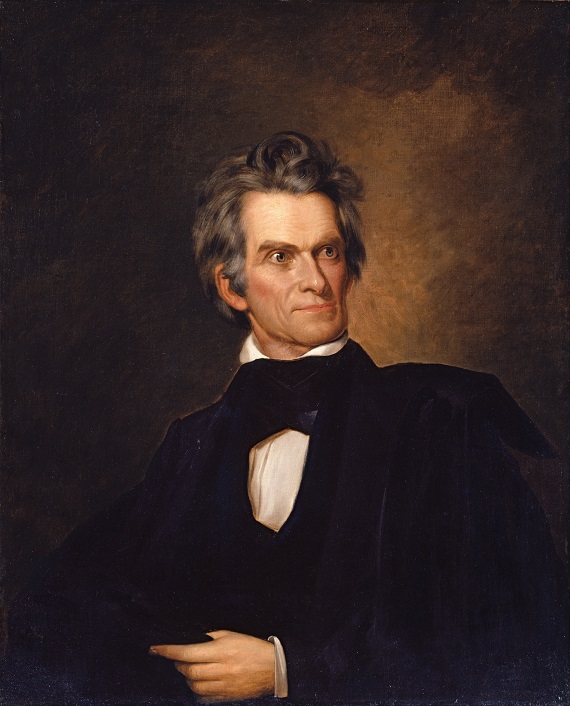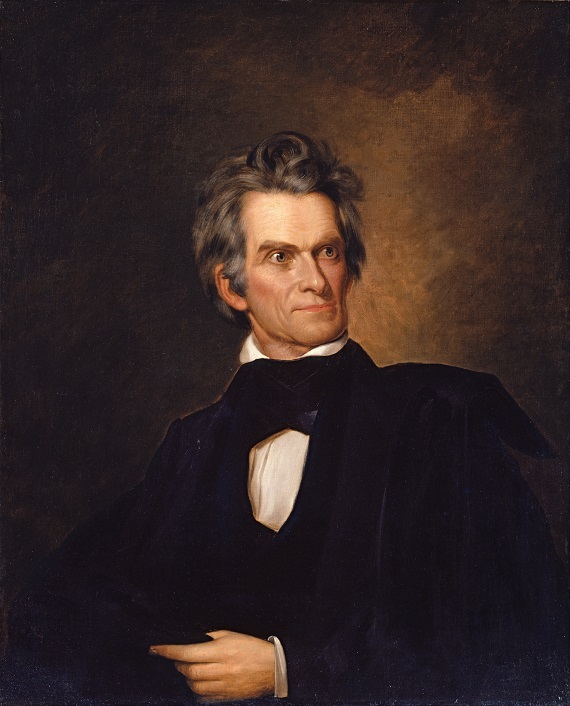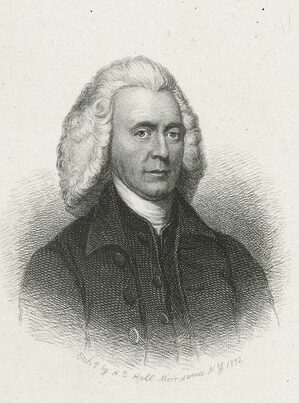Born in 1782 near Abbeville, South Carolina, Calhoun’s educational opportunities were limited, albeit advanced by the occasional tutelage offered by his brother-in-law, Reverend Moses Waddel. After his parents’ death and a period of self-education, Calhoun entered Yale College, studying under the arch-Federalist Dr. Timothy Dwight. He proceeded to study law for two years under Judge Tapping Reeve at the Litchfield Law School, the most prominent institution devoted to legal training during this period. Returning to his native South Carolina to practice law, a pursuit he considered “both dry and laborious,” Calhoun was married and served two terms in the South Carolina Legislature until elected to the U.S. House of Representatives in 1811. As a congressman, Calhoun continued to embody republican principles and acquired the reputation as a moral statesman who regarded republicanism and patriotism as synonymous: he supported the War of 1812; he revised Madison’s original national bank proposal and backed limited internal improvements; and he continued to praise a free economy and a regime founded upon “reason and equity” that was surrounded by a world of “fraud, violence or accident.”
As many have incorrectly noted, Calhoun supported “national” legislation during his early career according to these flawed accounts, encouraging scholars to inappropriately divide his life into stages based upon his perceived degree of attachment to a centralized political order. The rising protectionist spirit in America would also affirm Calhoun’s wisdom in supporting the 1816 measure, even though he held subsequent tariffs in disdain. President Monroe asked Calhoun to assume the helm at the War Department in 1817, where served until 1825.
Calhoun was generally considered too philosophical for such a practical post, but he accepted the appointment out of a republican sense of duty. In the course of two terms in office Calhoun completely reorganized and revitalized the War Department and its general staff, resolved its financial problems resulting from the war, and demonstrated a new, more compassionate approach to Native American affairs. Calhoun also began reforming West Point through a new spirit of openness in terms of admissions and administrative procedures. Calhoun has been described as the ablest war secretary the Government had before Jefferson Davis in 1853.
A broad spectrum of supporters encouraged Calhoun’s candidacy for President in 1824 against his fellow cabinet members William H. Crawford and John Quincy Adams, Speaker of the House Henry Clay, and war hero and newly-elected senator, Andrew Jackson. Initially entering the presidential field, Calhoun realized he lacked adequate support and withdrew after Pennsylvania nominated Andrew Jackson. Accepting the vice-presidential nomination, Calhoun was elected by a large majority. The results in the presidential contest between Jackson and Adams were inconclusive in terms of the electoral and popular vote, and the election was “thrown” into the House of Representatives where Jackson’s nemesis Clay served as speaker. In an unusual series of events, Clay came to Adams’s aid, with the House vote securing the election for Adams. The president-elect proceeded to appoint Clay as Secretary of State. Many Americans considered the supposed arrangement between Clay and Adams a “corrupt bargain.” Calhoun believed the “corrupt bargain” had disrupted the balance between preserving liberty and assuming power explicitly reserved to the people; “improperly acquired” power would doubtless be “improperly used,” he opined. Calhoun and either Adams or his representative engaged in a pseudonymous debate about the sources of political power. Calhoun began to separate himself from what he considered to be Adams’s abuses of office, and supported General Andrew Jackson in 1828. It was as part of this ticket, later known as the Democratic Party, that Calhoun was elected Vice President in 1828.
The falling apart of the political union between Calhoun and Jackson is one of the most remarkable events in American politics. Calhoun had hoped Jackson would assume the republican political mantel, but his expectations were not fulfilled. When Jackson decided to seek a second term and selected Martin Van Buren as his vice presidential candidate, several controversies were ignited that raised questions about the corruptibility of the administration. The most important concerned Mrs. Peggy Eaton, wife of Jackson’s dear friend and Secretary of War John H. Eaton. Out of a sense of propriety, Mrs. Calhoun and most ladies in Washington refused to receive her into their homes. After John Eaton made the controversy public, Calhoun was forced to respond and defend his wife’s actions, which amounted to a moral stance and not an act of snobbery as often noted.
As a result of the dispute with Jackson, Calhoun resigned as Vice President and was elected to the Senate. In an attempt to moderate the crisis posed by tariff-related concerns and the “Force Bill” in 1832, Calhoun questioned the prospect of preserving the union by force, and not relying on the “harmonious aggregate of the States.” To this point in his career as a statesman, Calhoun had made few statements regarding slavery. Troubled by the increasing influence of abolitionism and the rise of sectional conflict, Calhoun would devote the remainder of his life to defending the South and attempting to avoid conflict. Retiring from the Senate in 1843, he unsuccessfully pursued the presidency for the last time. In 1844, Calhoun was appointed as Secretary of State.
Returning to the Senate in 1845, Calhoun served as a thoughtful critic of the war with Mexico, and suggested the conflict would encourage disharmony between the North and South. In 1844, Calhoun had helped contain a truly revolutionary “Bluffton Movement” composed of his fellow South Carolinians. Many leading South Carolina politicians threatened drastic responses to a troublesome new tariff and the questionable status of Texas. Calhoun’s success at moderating the conflict demonstrated both his restraint in a crisis situation and his lack of control over the politicians often described as “Calhounites” due to their intimate ties to the statesman.
Published after his death, Calhoun’s two treatises on political theory and American constitutionalism, the Disquisition and Discourse, demonstrate his hope that America could avoid the pending conflict. Calhoun’s persistent concern about the unequal treatment of the South would, he feared, lead to increased regional tensions and to civil war. His last years were spent attempting to unify the South and avoid strife. On March 31, 1850, Calhoun died in Washington, D.C. In death, Calhoun became a source of inspiration for the Confederate government, its leaders, and the South. Calhoun’s understanding of restraint within political order, albeit imperfect, remains one of the most important characteristics of his political thought and his achievement as a statesman. In Calhoun’s interpretation, the interposing and amending power of the states implicit in the Constitution could only augment authentic popular rule by allowing for a greater diffusion of authority. Calhoun’s purpose was the preservation of the original balance of authority and the fortification of the American political system against the obstacles it faced.
Books
Butta, Giuseppe. Democrazia e Federalismo: John C. Calhoun. Messina: Edizioni, 2002.
Carpenter, Jesse T. The South as a Conscious Minority, 1789-1861. New York: New York University Press, 1930; reprint, Columbia: University of South Carolina Press, 1990.
Cheek, Jr., H. Lee. Calhoun and Popular Rule. Columbia and London: University of Missouri Press, 2001.
Cheek, Jr., H. Lee, Sean R. Busick, and Carey Roberts, Editors. Republicanism and Liberty: The “Patrick Henry”–“Onslow” Debate. Lanham, Maryland: Lexington Books, 2013.
Coit, Margaret L. John C. Calhoun: American Portrait. Boston: Houghton Mifflin Company, 1950.
Coit, Margaret L., Editor. Great Lives Observed: John C. Calhoun. Englewood Cliffs, New Jersey: Prentice-Hall, 1970.
Morley, Felix. Freedom and Federalism. Indianapolis, Indiana: Liberty Fund, 1981.
Peterson, Merrill D. The Great Triumvirate: Webster, Clay, and Calhoun. New York: Oxford University Press, 1987.
Spain, August O. The Political Theory of John C. Calhoun. New York: Bookman Associates, 1951.
Styron, Arthur. The Cast-Iron Man: John C. Calhoun and American Democracy. New York: Longmans, Green and Company, 1935.
Wilson, Clyde. John C. Calhoun: A Bibliography. Westport, Connecticut: Meckler, 1990.
Wiltse, Charles M. John C. Calhoun: Nationalist, 1782-1828. Indianapolis: Bobbs-Merrill Company, 1944.
Wiltse, Charles M. John C. Calhoun: Nullifier, 1829-1839. Indianapolis: Bobbs-Merrill Company, 1949.
Wiltse, Charles M. John C. Calhoun: Sectionalist, 1840-1850. Indianapolis: Bobbs-Merrill Company, 1951.
Articles
Cheek, Jr., H. Lee. “A Tenor of Discontent: Calhoun and His Critics.” Telos, Number 118 (March
2001), pp. 59-76.
Cheek, Jr., H. Lee. “Calhoun, Sectional Conflict, and Modern America.” Journal of Libertarian
Studies, Volume 16, Number 2 (Spring 2002), pp. 35-55.
Davis, Jefferson. “Life and Character of the Hon. John Caldwell Calhoun.” North American Review, Volume CXLV (September 1887), pp. 246-260.
Drucker, Peter. “A Key to American Politics: Calhoun’s Pluralism.” Review of Politics, Volume 10, Number 4 (October 1948), pp. 412-426.
Elwell, Margaret Coit. “The Continuing Relevance of John C. Calhoun.” Continuity: A Journal of History, Volume 9 (Fall 1984), pp. 73-85.
Faulkner, Ronnie W. “Taking John C. Calhoun to the United Nations.” Polity, Volume 15 (Summer 1983), pp. 473-491.
Gutzman, Kevin. R. C. “Paul to Jeremiah: Calhoun’s Abandonment of Nationalism.” Journal of Libertarian Studies, Volume 16, Number 2, pp. 3-33.
Herzberg, Roberta. “An Analytic Choice Approach to Concurrent Majorities: The Revelance of John C. Calhoun’s Theory of Institutional Design.” Journal of Politics, Volume 54, Number 1 (February 1992), pp. 54-81.
Kirk, Russell. “Southern Conservatism: Randolph and Calhoun.” Chapter in The Conservative Mind: From Burke to Santayana. Chicago: Henry Regnery, 1953, pp. 130-160.
Tabarrok, Alexander, and Tyler Cowen. “The Public Choice Theory of John C. Calhoun.” Journal of Institutional and Theoretical Economics, Volume 148, Number 4 (December 1992), pp. 655-674.
Wilson, Clyde N. “Calhoun and Community.” Chronicles, July 1985, pp. 17-20.
Wilson, Clyde N. “John Caldwell Calhoun.” Dictionary of Literary Biography, Volume 3. Edited by Joel Myerson. Detroit: Gale Research Company, 1979, pp. 44-54.
Wilson, Clyde N. “Free Trade: No Debt: Separation from Banks: The Economic Platform of John C. Calhoun.” Chapter in Slavery, Secession, and Southern History. Charlottesville: University Press of Virginia, 2000.








One Comment